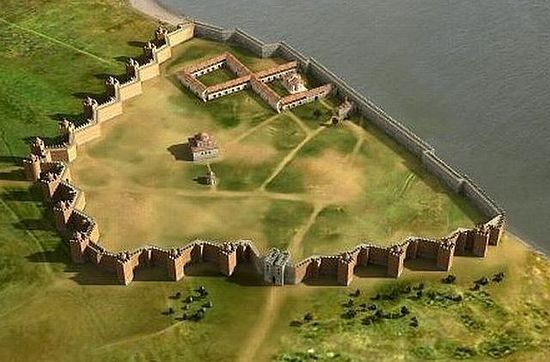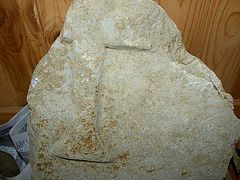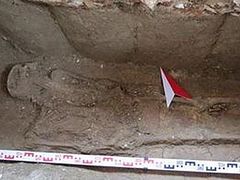Source: Archaeology in Bulgaria
October 16, 2015
The ruins of what was the oldest Christian church from the period of the Middle Ages in the ancient and medieval city of Drastar (known as Durustorum in the Roman period) have been discoveredduring the continuing rescue excavations in Bulgaria’s Danube city of Silistra.
The rescue digs in Silistra, which was a major regional center in the Antiquity and Middle Ages, have been going on for several months as part of the rehabilitation of the city’s water supply and sewerage system.
As a result the local archaeologists from the Silistra Regional Museum of History and their colleagues from the nearby cities have excavated dozens of buildings from the time of the Roman Empire, the Byzantine Empire, and First Bulgarian Empire (632/680-1018 AD).
The latest discovery in Bulgaria’s Silistra is a church which dates back to the 2nd half of the 9th century AD, the period right after the First Bulgarian Empire formally adopted Christianity as a state religion in 865 AD.
This was the earliest medieval church in Drastar, then a major Bulgarian fortress, according to lead archaeologist Prof. Georgi Atanasov from the Silistra Museum, as cited by BTA.
The early medieval church was about 6 meters wide, and its walls were 1.3 meters thick.
The ruins of the newly found church have been discovered under the floor of another church – a 10thcentury AD Patriarch’s cathedral found at the end of August 2015, which has turned out to be thesecond Patriarch’s temple in the medieval city of Drastar from that period.
Back then the archaeologists described the newly found cathedral which is a basilica as “one of the top five temples in Bulgarian archaeology”.
At the instructions of a commission of the Bulgarian government, the newly unearthed ruins in Silistra will be conserved by protecting them with sacks of sand; they will be reburied until some major funding is found for their exhibition in situ in the future.
The First Bulgarian Empire formally adopted Christianity as a state religion in 865 AD from Byzantium, after a protracted battle between Rome and Constantinople over who would convert theBulgarians. In 870 AD, the head of the Bulgarian Orthodox Church was granted the rank ofArchbishop.
In 917 AD, following his overwhelming defeat of the Byzantines in the Battle of Anchialos, the Bulgarian Tsar Simeon I the Great (r. 893-927 AD) is believed to have declared the head of the Bulgarian Orthodox Church a Patriarch. The title, however, was recognized by the Byzantine Empire after Tsar Simeon’s death in 927 AD, under his son, St. Tsar Petar I (r. 927-969 AD). Thus, the Bulgarian Patriarchate itself had its inception at the beginning of the 10th century AD.
Despite the impressive archaeological discoveries in Silistra over the past few months, thearchaeologists’ priority are the rescue excavations alongside the construction works which has put them on a hectic schedule, and which means that for the time being the newly unearthed structures will not be exhibited in situ.
About 75% of the construction works for the new water supply system in Silistra are located in the Archaeological and Architectural Preserve “Durostorum – Drastar”; the digs reach a depth of 4-5 meters, which allows the archaeologists to discover important artifacts and archaeological structures literally every day.
Several archaeological structures uncovered in the previous stages of the rescue excavations have already been re-buried which has understandingly sparked outrage on part of local development activities who have criticized both the local and the central government for its failure to preserve Silistra’s unique historical, cultural, and archaeological heritage, and to use it to boost tourism.
Background Infonotes:
The Ancient Thracian and Roman city of Durostorum (Dorostorum) – known as Dorostol or Drastar (Drustur) during the periods of the Bulgarian Empire in the Middle Ages – is the precursor of today’s Bulgarian city of Silistra. It was originally founded as an Ancient Thracian settlement on the Lower Danube. In 29 AD, the Romans built there a fortress keeping the settlement’sThracian name of Durostorum (or Dorostorum). After his victories wars over the Dacians north of the Danube, Roman Emperor Trajan stationed the elite Claudius’ 11th Legion – Legio XI Claudia – at Durostorum, and the fortress remained its permanent seat until the demise of the Roman Empire. In 169 AD, during the reign of Emperor Marcus Aurelius (r. 161-180 AD), Durostorum was made a Roman city – a municipium. Between the 2nd and the 4th century AD, it was a major urban and military center of the Roman Province of Moesia Inferior (later divided into Moesia Secunda and Scythia Minor), and amajor Roman stronghold against the barbarian invasions. The earliest 12 Christian saints from the territory of today’s Bulgaria are Roman soldiers executed in Durostorum during the Great Persecution of Emperor Diocletian between 303 and 313 AD, including St. Dasius and St. Julius the Veteran. In 388 AD, today’s Silistra became the seat of a Christian bishopric. Roman general Flavius Aetius (391-454 AD), who is known as “the last of the Romans” for his army’s victory over the Huns in the Battle of the Catalaunian Plains in 451 AD, was born in Durostorum. During the barbarian invasions of Sarmatians, Goths, Huns, Avars, Slavs, and Bulgars the city was ransacked several times. It was rebuilt during the reign of Byzantine Emperor Justinian I the Great (r. 527-565 AD).
The Slavs settled in Durostorum around 590 AD, and named it Drastar (Drustur). The city became part of the First Bulgarian Empire (632/680 – 1018 AD) around 680 AD. Bulgarian Khan (or Kanas) Omurtag (r. 814-831 AD) is known to have built there a large imperial palace known as the Danube Palace of Bulgarian Khans where later Bulgarian Tsar Simeon I the Great (r. 893-927 AD) resided in 896-897 AD. In 895 AD (during the Bulgarian-Hungarian War of 894-896 AD), the Magyars(Hungarians), allies of Byzantium, besieged the Bulgarian army under the personal command of Tsar Simeon I the Great in the fortress of Drastar but were repulsed. The next year the Magyars were decisively defeated by the Bulgarians in the extremely fierce Battle of Southern Buh (in today’s Ukraine) which eventually led their tribes to retreat to the west and settle in the region of Pannoniaessentially founding today’s Hungary.
During the later years of the First Bulgarian Empire the region around today’s Silistra was known for its rock monasteries. In 927 AD, Drastar became the seat of the first internationally recognizedPatriarch of the Bulgarian Orthodox Church, Patriarch Damyan. In 969 AD, it was captured by Knyaz Sviatoslav I of Kiev, the ruler of Kievan Rus in 945-972 AD, but two years later it was conquered byByzantium under Emperor John I Tzimiskes (r. 969-976 AD) in the Battle of Dorostolon, and renamedTheodoropolis, after military saint Theodore Stratelates. In 976 AD, Bulgaria’s Tsar Samuil (Samuel) (r. 977/997-1014 AD) regained the city until 1001 AD when it was again conquered by the Byzantine Empire.
Drastar was a metropolitan’s residence and a major fortress during the Second Bulgarian Empire (1185-1396 AD). In 1279 AD, under Tsar Ivailo (r. 1277-1280), Drastar withstood a three-month siege by the Mongols. It was conquered by the invading Ottoman Turks in 1388 AD (ca. 1400 AD, according to some sources), and turned into a major Ottoman fortress. Subsequently, Silistra has remained a major urban center in the Lower Danube region.




